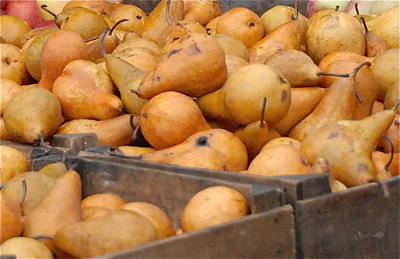
Some food moments stay with you forever. For me, it’s that first bite of a pear. Thinking that he’d introduce his only child to a delightful, new food, my father had plucked a pear from his lone fruit tree and handed it over to four-year-old me. Willing to please and try anything, I chomped into the golden skin and pulled off a huge piece. It all went downhill from there.
As the story goes, I grimaced, pronounced the pear “gritty” and spit out the offending, unripened piece. That’s the assessment that I made over three decades ago and the one that I’d cling to for almost as long. Care for a pear? No thank you!
Today, though, I’m quite fond of this bell-shaped fruit. When allowed to ripen off the tree, it can be a divine treat. With over 1,000 varieties and seasons that spread throughout the year I can find a soft, honeyed pear almost anywhere.
Similar to its cousin, the apple, the pear originated in the border between Europe and Asia known as the Caucasus. Spread by traveling Aryan tribes, it moved into North India and Europe. Eventually it arrived in China as well as in America where it became wildly popular in 19th century New England. In the U.S. most of our pears now come from Washington, Oregon and California.
In ancient times the pear was considered superior to apples, more or less the perfect fruit. Its fragrant and juicy flesh made it a beloved dessert. As varieties developed and spread, it also become a favorite for cooking. No wonder. In terms of cooking a pear responds well to a range of methods including baking, grilling, poaching, roasting, sauteing and stewing. It compliments a wealth of foods including almonds, cheese, chocolate, duck, ginger, oranges, pork, raisins, walnuts and wine.
When selecting pears, I look for shiny, firm, unblemished fruit. At home I put them in a cool spot to ripen. When ripe, they are tender, aromatic and easily bruised. I use mature pears right away or refrigerate them to stave off spoilage.
Now that I know how to choose and, most importantly, not to eat immature pears, I use them in an assortment of dishes. I slice and saute them in a sugar and butter and serve them over ice cream. I chop and add them to salads or pair them with Gorganzola, Stilton, Parmesan or Brie cheese and serve them as a first course. My favorite way to prepare pears, though, is to feature them in a tart.
GINGERED PEAR TART
Serves 6
5 pears, peeled, cored and sliced
6 tablespoons unsalted butter
¾ cup granulated sugar
½ teaspoon ground ginger
1/8 teaspoon ground cinnamon
1 sheet (roughly ½ pound) frozen puff pastry, defrosted and cut to fit a 9-inch frying pan
Preheat the oven to 375 degrees Fahrenheit.
Melt the butter, sugar, ginger and cinnamon together in a 9-inch, oven proof pan. Arrange the pear slices in the pan and cook over medium heat for 15 minutes or until a light colored caramel has formed in the pan.
Place the pastry over the pears. Tuck in any extra pastry and then place the pan in the oven. Bake for 20 minutes or until the pastry has turned golden brown. Remove the pan from the oven and allow it to cool.
Invert the pear tart onto a large serving dish and serve warm.